#Lambert-Warner
Explore tagged Tumblr posts
Text
Coy & Coited
Do any Wichita P.D. who attended highschool with me want to smoke some dope with me & watch/broadcast a video of my grade school coach forced into a dress, sodomized by underaged illegal immigrants and executed for global terrorism? Big fat secret. I am in no way from a big city. I know my way around equine activities and hail from a small town called "Olpe". I grew up there if you ask some. Truth be told, we moved out of town when I where still just a pre-teen & to be retired as a prostitute. Prostitutes are to be retired by the age of 9, we aren't to be yanked out of retirement at the age of 44.
I might rather enjoy smoking cocaine & watching a television broadcast with Officer Rusco. She a ho, dontchya know riding she hår-se impeding traffic, all over the ghetto.
Too: I could use a pistol of my own.
We have to work for W.B. on this note. My aunt sort of cashed out corporate stock in Warner Bros to pay for a funeral or three in the area of Emporia that I never attended. When she does this kind of shit, it puts me under slave contract to work for them: which often becomes just throwing an idea at corporate.
Then corporate has to do it & see if it would make for good television or not. Should the original film be rejected: it must be repeated in society until something good for television pops up. I am sure we can find enough egotistical jackasses in & from Kansas who've had my name in their sodomous pork eating mouths to force into a dress, rape up the ass, kill on stage, beat their women half to death, leave them in the streets with their identities stolen and credit maxed out: and call it "groovy" until the general American public are laughing.
and call the global broadcast...
Just Therapy
#Wichita#Wichita PD#Police#People#Highschool#Warner Bros#Snoop Dogg#WB#Lambert-Warner#Coach Lambert#Menlo#Menlo Park#Anaheim#California Gangs#Gay Gangs#Dr.A.G.#Cocaine#Dope
0 notes
Text




#Madonna#1984#Like A Virgin#Mary Lambert#Venice#Italy#Warner Brothers#Sire Records#Warner Home Video#my gifs#Madonna 1984#Queen Of Pop
22 notes
·
View notes
Text

Henry G. Parks, Jr., (September 29, 1916 - April 24, 1989) is known as the founder of H.G. Parks, Inc., the first African American corporation to be listed on the NYSE.
With a combination of savings and scholarships, he matriculated at Ohio State University, graduating in 1938 with honors. As a student at OSU, he became a member of the National Urban League and Alpha Phi Alpha Fraternity.
He became part-owner of a two-man public relations business, W. B. Graham Associates, in NYC. He was part-owner of the Crayton Sausage Company of Cleveland. He moved to Baltimore where he became a real estate broker, owner of two drug stores in African American neighborhoods, and a cinderblock business.
He established the Parks Sausage Company which he headquartered in Baltimore. The following year the USDA agreed to regular inspection of Parks Sausages. He was operating a multimillion-dollar corporation selling his pork products as far north as CT and as far south as VA.
He appeared on the cover of Business Week. He joined the board of directors of First Pennsylvania Corporation, Magnavox, W. R. Grace and Company, and Warner-Lambert. He took Parks Sausage public. The Norin Corporation acquired more than 95% of the outstanding common stock of the Parks Company and he retired from the business at the age of 61.
He was elected to the Baltimore City Council and served two consecutive terms. By this time he was a life member of the Fraternity, the NAACP, and the NUL. He became the first African American to serve on the Board of Trustees of Goucher College in Baltimore. He was elected to the board of trustees of Provident Hospital in Baltimore County and Baltimore City respectively. He was designated a Distinguished American by the US Congress. #africanhistory365 #africanexcellence #alphaphialpha
4 notes
·
View notes
Text


Special thanks goes out to Co-op America, and responsibleshopper.org, whose publications aided in the research of this chapter.]
Section I: Abuse of the Consumer (Modern)
Abbott Laboratories sold genetically engineered baby food in the Indian Market — the food had not medical approval and many instances of genetically engineered foods have included the illness and fatalities of many. [663] Customers in the Cincinnati area are charged 57% more for Delta Airlines flights than any other region. [664] Disney is opposed to any legislation that would regulate the safety of amusement park rides. [665] Mitsubishi admitted to “systematically concealing defects and avoiding the recall of thousands of vehicles over the past two decades.” [666] In the early 1990’s, Archer Daniels Midland had engaged in a price-fixing scheme for additives in animal feed. [667] ConAgra, Ortho Pharmaceutical Corporation, and Warner-Lambert Co. were named top 100 corporate criminals of the 1990’s, whose fraud allegations have resulted in fines exceeding millions. [668] In April of 1996, security guards were stopping many of its customers — later it would be confirmed that all African American customers were followed and treated as suspects [669] General Motors and Honda Motors were two of five auto makers to pay $1.9 million in fines because of hiding lease terms in contracts. [670] Mazda Motors paid over five million total for confusing leasing promotions in 1997. [671] Quaker State advertised that its engine treatment oil reduced engine wear, but such claims were unproven. [672] In 1998, American Airlines was discovered to have 51 violations of FAA rules to protect its customers. [673] In one year, three people were killed by falling merchandise at Home Depot. [674] Monsanto’s genetically engineered growth hormone (rBGH) has been shown to increase prostate cancer in males. [675] In 1998, Owens-Corning was responsible for 176,000 asbestos poisoning cases. [676] In 1998, three African-Americans at a Shoney’s restaurant were harassed, intimidated, and finally the store refused to serve them. [677] In August of 1998, more than 10 safety violations were found with Continental Airlines. [678]
USAirways uses pesticide regularly on its flights, even though scientists believe that it could threaten the health of passengers. [679] Montsanto’s director told The Now York Times: “Monsanto should not have to vouchsafe the safety of biotech food. Our interest is in selling as much of it as possible. Assuring its safety is the FDA’s job.” [680] In 1998, two white Eddie Bauer security guards told a black teen to remove his shirt and told him to go home shirtless to get a receipt for the shirt. [681] The Federal Trade Commission and Justice Department are investigating Citigroup for use of deceptive lending terms and high fees that strip away equity. [682] A court ruled that General Electric Company was “deceptive” when selling dishwashers in 1999 that had a fire hazard. [683] Smurfit-Stone Container Corp. has produced faulty siding for homes that would prematurely fail, so as to get a returning customer. In a lawsuit, it may have to pay over $20 million. [684] In January of 1999, 7,000 customers of Northwest Airlines were subjected to 11 hours of waiting, with overflowing toilets and lack of food. [685] It has been concluded by the National Highway Traffic Safety Administration that as of May 1, of 1999, air bags used by DaimlerChrysler had killed 76 children and saved none. [686] In June of 1999, two minority women at a Dillard’s store were searched for stolen merchandise, only to find receipts for everything. They were detained for another hour and issued citations for fabricated offenses, and then charged with criminal trespassing. The same thing has happened in previous years of minority customers being detained and accused of shoplifting. [687] Toyota hes released 2.2 million vehicles to customers with faulty pollution-detection systems. [688] Delta Airlines was fined $77,000 by the Federal Aviation Administration for failing to adhere to safety regulations. [689] Investors of Fruit of the Loom, between September of 1998 and November of 1999, were issued false and misleading statements, artificially inflating the price of the stock. [690]
In October of 1999, Abbott Laboratories sells Prevacid, an ulcer medication, for $393 for a standard dosage. [691] When an independent pharmacy in New York City closed, it sold its customers records to CVS and other corporations — violating the privacy of hundreds. [692] In December of 1999, K-B Toys refused to accept personal checks from black customers, but accepted them from white customers. [693] Federated Department Stores has store aisles that are 17 inches wide, disallowing customers with wheelchairs. [694] In 1999, Toys ‘R’ Us was employing over 300 employees aged 14 and 15, at 19 stores, working longer hours and late in the night, violating labor law. [695] In 2002, Amazon.com used spyware to steal personal information about its customers. [696] Bank One settled a class action case for issuing improper late fees and interest rate increases, as well as lying about its financial status to investors. [697] Ford Motors knew of at least 35 deaths and 130 injuries relating to its tires without taking any action. [698] Kmart in 2000 decided to eliminate the sale of mouth toys containing phthalates (“Some phthalates cause liver cancer, kidney damage and reproductive system impairment in animals.”), but no other dangerous chemicals. [699] In early 2000, Rite Aid did not allow their ATM machines accessible to disable customers. [700] Toys R Us promised that it could deliver toys by Christmas in 2000, but knew it could not deliver its promises. [701] Tyson Fresh Meats was found guilty of stealing C&F Packing Company’s secret process for making pre-cooked Italian sausage pizza topping, and then undercut C&F’s prices. [702] In February of 2000, Black & Decker failed to inform the public about potential fire hazards from one of its toaster models. [703]
In March of 2000, the presence of lead was found in Johnson & Johnson baby powders. Lead is capable of causing psychological problems. [704] In March of 2000, KBToys refused to take checks from African-Americans. [705] Sanyo Electric Co. released over 10,000 solar cell systems that were faulty and inefficient. [706] Wyeth Corporation recently was prosecuted by many of its customers for the diet drug fen-phen, which caused destroyed heart valves and strokes. [707] In May of 2000, Continental Airlines hiked up its fares during a time of record profits. [708] Northwest Airlines shipped a container of compressed hydrogen, which could have destroyed the plane and its private passengers. [709] In 2000 of June, American Airlines failed to make fulfill security regulations. [710] The US FDA seized syringes by Abbott Laboratories for failing to meet up production standards. [711] MCI Worldcom in June of 2000 changed their customer’s long-distance plans without their permission. [712] In June of 2000, Sprint misled customers about fine-print restrictions and add-costs. [713] In July of 2000, Qwest Communications paid $1.5 million for changing their customers long distance service without their permission. [714] 21 reported traffic deaths in August of 2000 were linked to the Ford Motor tires. [715] Alltel has overcharged customers between $130 million and $140 million since 1996. [716] Amazon.com uses a strategy called “dynamic pricing,” where they “gauges a shopper’s desire, measures his or her means, and charges that shopper accordingly.” [717] Amazon.com stated that it considers customer information an asset, and that it may potentially be sold. [718] In September of 2000, CVS shared the information of a Maryland couple and violated confidentiality laws. [719] Ford Motor’s engineers, safety officials, and board were aware of the faultiness of its ignition system that caused cars to shut down — resulting in deadly and other serious accidents. [720] MBNA Corp. placed misleading ads, saying that there was a charge of 6.9 percent for new credit card customers, whereas it was mostly 17.9 percent on new purchases. [721] PG&E passed $4.63 billion in profits to its parent company, but filed for bankruptcy, losing its investors all their money. [722]
In October of 2000, Humana (an HMO) offered its doctors incentives to steer patients away from using treatments. [723] MCI WorldCom has ripped off 5 million customers with surcharges of up to $88 million. [724] Owens-Corning filed bankruptcy because its asbestos-containing products damaged enough people, with a liability as high as $7 billion. [725] In 2000 of October, a woman died after a Rite Aid pharmacist erroneously doubled her prescription. [726] In that same month, Rite Aid overcharged 29,000 uninsured customers of up to $500,000. [727] Wyeth Corporation had repeatedly violated manufacturing standards at two of its drug factories. [728] Wyeth Corporation, in that same month, had to pay $4.7 billion to consumers for the fen-phen drug combination, which resulted in fatal heart valve damage and pulmonary hypertension. [729] In November of 2000, Abbott Laboratories failed to meet quality standards of hundreds of medical testing kits. [730] 6,500 trust account beneficiaries were cheated out of refunds owed to them by Bank of America, amounting to $35 million. [731] CIGNA and ACE breached their insurance contracts of up to $27 million in insurance premiums. [732] Goodyear Tire & Rubber knew about the failure of Firestone tires for over four years. [733] In November of 2000, Goodyear was linked to 15 deaths in accidents with their tires. [734] Morgan Stanley Dean Whitter mislead its investors into losing $65 million. [735] Three directors at Priceline.com used inside information to sell stock of the company, profiting up to $247 million. [736] Tens of thousands of Californian customers were billed by Qwest Communications for services they never ordered, or had their long-distance service switched without their permission. [737] Rite Aid sells prescription drugs at a lower cost to those who have insurance. [738] Also in November of 2000, Rite Aid released misleading information that artificially inflated the company’s stock price, causing damages up to $200 million. [739]
In December of 2000, Gateway Inc. has misled investors about financial statements. [740] Rite Aid pharmacies offered discounts on cash-only prescriptions, but had added hidden charges. [741] In 2001, two ConAgra plants were halted because of health violations. Another ConAgra facility had the highest rate of salmonella of all turkey processors tested during 2001. [742] In 2001, Enron “cheating millions of investors out of billions of dollars.” [743] In 2001, a severed rat’s head in a McDonald’s hamburger was partially ingested by a nine-year old girl. [744] Mellon Financial Corp. was contracted by the IRS to do tax returns, but ended up destroying up to 71,257 tax returns, worth $1.2 billion. [745] In fall of 2000, Priceline.com and its key officers and directors omitted material information and disseminated false and misleading statements concerning the company’s financial condition. [746] Reebok uses PVC in its shoes, which can cause toxic dioxins. [747] Schering-Plough failed to tell its customers that its drug Claritin is only effective for about half of its users. [748] In January of 2001, Allstate discouraged people from hiring attorneys, violating consumer-protection law. [749] Disneyland was found at fault for an accident where a four-year-old boy was brain damaged by one of the rides. [750] Federated Department Stores had two of its black customers arrested for using a stolen credit card, though no evidence existed to prove this besides a $1,000 purchase. [751] International Forest Products Limited managed to use deceptive contract tactics to sidestep the government’s fees by $224 million. [752] Time Warner Inc. has sent magazines, books, CDs, etc., to hundreds of Florida consumers who never ordered them and then charged them for it. [753]
In February of 2001, lawsuits were filed against Aetna, CIGNA Corporation, and four other major HMOs, claiming that the company delayed payments, affecting healthcare of patients. [754] Bausch & Lomb conspired with American Optometric Association to force customers into buying replacement contact lenses, in 32 states. [755] One customer at Kmart was arguing about a rebate with a salesman when a security guard tackled him, and then beat him into unconsciousness. The security guard was promoted, even though he had attacked other customers. [756] Nike executives sold stock just before announcing poor earnings, resulting in the stock plunging. [757] PG&E executives sold stock before the company issued a bankruptcy warning that sent stocks into a decline. [758] Pharmacia Corporation in February of 2001 misled its customers about Celebrex, minimizing crucial risk information about the drug. [759] Clothing sold by Wal-Mart has shown a tendency to easily catch on fire; during a trial concerning this, the judge found the company “repeatedly concealed documents and witnesses.” [760] Wyeth Corporation has been using blood, fetal calf serum, and meat broth (high potential of mad cow disease) from cattle for over eight years, stopping in 2001. [761] In March of 2001, Chrysler bought back defective vehicles from customers, only to resell them. [762] Kmart sold a faulty pellet gun to a teenager, whose was brain damaged after he was accidentally shot in the head with it. [763] Schering-Plough is under investigation for causing an inflation in government reimbursed drugs, as well as shorting Medicaid payments. [764]
In April of 2001, CompUSA promoted product rebates without stating up front that customers had to sign up for three years of internet service. [765] Security guards who work for Dillard’s have routinely harassed and beaten black customers, leaving one person dead. News stations that carried the stories, such as CBS, had advertising funds pulled — while ABC and NBC didn’t cover the report and continued with Dillard’s advertising. [766] In April of 2001, a black woman was denied a free cologne sample from Dillard’s. [767] Federated Department Stores sold flammable children’s pajamas and robes. [768] Johnson & Johnson agreed to pay a settlement of $860 million, because the instructions on its contact lenses was to throw them away after one day, when they can be worn for two weeks. [769] In April of 2001, security guards for Rite Aid killed a woman who was trying to shoplift. [770] Wells Fargo & Co. realty website would only link shoppers to neighborhoods with the same income and racial makeup of the shopper’s current neighborhood. [771] Abbott Laboratories hiked up its prices and bribed doctors to prescribe Lupron Depot. [772] AstraZeneca cooperated with other companies to maintain unreasonably high prices for the breast cancer drug Tamoxifen. [773] Dillard’s was involved in the death of one man at its stores; the store claimed the man was psychotic, police came and handcuffed the man, and then witnesses claim to have seen the officers beat the handcuffed man who died two days later. [774] In May of 2001, Dillard’s was ordered to pay more than one million dollars by the courts, for detaining two minority women and accusing them of shoplifting. [775] Dow Chemical sold Dursban for home and garden use, when it was a proven hazardous substance. [776] In May 2001, a California state appeals court upheld the $26 million verdict against Ford Motor, whose Bronco II sport utility model has caused one man to become quadriplegic and unable to breathe without a ventilator. [777] In May of 2001, Hilton Hotels, Hyatt, Marriot International, Starwood Hotels & Resorts, and one other corporation added energy surcharges onto guests bills that weren’t apparent until guests were checking out. [778]
Cardura, a drug sold by Pfizer, has been linked to increased heart failure, but the company has issued no safety warning yet. [779] A 10 year-old boy died after taking Dimetapp. Wyeth Corporation failed to provide a warning that a key ingredient could be dangerous for children. [780] Abbott Laboratories had a patient undergo chemotherapy, a hysterectomy, and a partial lung removal after being diagnosed with cancer that she never had. “The doctors did not follow proper medical practice. A simple urine test would have prevented this tragedy,” said an Abbott spokeswoman. [781] In June of 2001, American Airlines was found in 197 instances that violated regulations for batteries and battery charger maintenance, for its emergency floor lights. [782] Circuit City refused to take rainchecks to customers for out-of-stock sale items that were advertised, violating a state consumer protection law. [783] In June of 2001, Eli Lilly sent out an e-mail message to 600 people, reminding them to take their dose of Prozac — each person received everyone else’s e-mail address, violating privacy. [784] In June of 2001, Mattel Inc. was fined for failing to report defects in its Power Wheels line of toys, causing fires and electrical failures. [785] Sara Lee Corp. plead guilty in June of 2001 to selling contaminated hot dugs and meats in 1998 — causing 100 illnesses, six miscarriages, and 15 deaths. [786] SBC Communications failed to meet standards in wholesale service to its rivals. [787] SBC Communications had to yank adds criticizing a rivals’ cable modem operations for slow service during peak hours, when its own service was equally susceptible to slowdowns. [788] Sony created a phony film critic to invent quotations to provide positive reviews for its Sony films. So-called moviegoers praising Son films in promotion ads were actually employees of Sony. [789] In June of 2001, Viacom made customers pay inflated fees for overdue rentals between 1992 and 2001. [790]
In July of 2001, American Airlines changed the rules to its frequent flier program once customers signed up by limiting seats. [791] A three-months pregnant woman shopping at Dillard’s was detained and strip-searched. No stolen items were found. [792] Interstate Bakeries produces bread made with bromate, a chemical that causes cancer in rats. [793] Microsoft Corporation’s Passport identification system allows the company to become a storehouse of personal data, being ripe for abuse. [794] Frito-Lay Inc. is trying to permanently seal records that show its snack foods were contaminated with toxic solvents. [795] In August of 2001, Aetna, Cigna, Emipire Blue Cross/Blue Shield, Excellus, Oxford, and United Health Care were being sued for engaging in illegal practices and routinely breaching the terms of contracts with physicians. [796] Limited Brands imported and sold flammable children’s sleepwear, having to recall 390,000 pajamas and 17,600 robes. [797] May Department Stores did not comply with American Disabilities Act. [798] A report obtained through the Freedom of Information Act revealed that Sara Lee knew it was shipping tainted hot dogs and deli meats. They were aware of increased levels of listeria before the listeriosis outbreak that killed 15. [799] United Airlines uses pesticides in the cabins of its planes, where some attendants developed rashes, and customers were potentially harmed. [800] In September of 2001, AstraZeneca was found to be pricing medications above the allowed maximum. [801] Merck advertised its drug Vioxx saying the company minimized potential risks, when a preliminary study indicated the drug caused an increased risk of heart attack and stroke. [802] Shortly after the Sept 11th terrorist attacks, Northwest Airlines forced four Arab-American men to leave a plane. [803] Verizon knowingly marked cell phones that exposed users to radiation. [804]
#class consciousness#capitalism#class#class struggle#communism#civilization#money#classism#anti capitalism#anti classism#consumption#economics#industrial society#poverty#workers#labor#anarchism#anarchy#anarchist society#practical anarchy#practical anarchism#resistance#autonomy#revolution#anti capitalist#late stage capitalism#daily posts#libraries#leftism#social issues
3 notes
·
View notes
Text
Welp-
I was hoping to have these fellas digitized first before I introduced them, but I feel like I have been prolonging them long enough.
So allow me to introduce y'all to the OCs I made based off Twisted Wonderland [if you don't know what that is, imagine Harry Potter mixed with hot anime boys based off the Disney villains packed in a mobile game].
These characters go towards a fanfiction idea I have for a Future AU, "Twisted Wonderland: A Tale Rewoven". There are a total of seven houses. The college is Co-ed though, so not all of them are male. You will recognize a couple of these characters from my Pride month drawing:
I won't cram you with character backstories yet, but the run down is basically:
Farcifabula, a house built on the fundamentals of fun, creative outlets. These students each bring their own contributions to developing research in child psychology and playtime technology. Though, some of the students may struggle a bit with the concept...
Clemens Lovemore (house leader)
Liz Sharpe
Erika Peterson (co-leader)
Montague Montgomery, or "Monty Monty"
Bella Mannikin

Mutateiligi, an online house that focuses on learning computer programming and technological services. There is a secret to the house's true purpose though...
Dulce Sucorona (house leader)
Vert Bitters (co-leader)

Maanombra, a house that's infamous for its shady students. What is often overlooked though is that the students here are calculating, and have a knack for mathematics- which many link to the student's alleged gambling practices.
Ban Schmatte (house leader)
Gauge Laflamme (co-leader)
Ashen Malfatto
Clip Marrow

Omnismahtava, a house for the ambitious and the genius! The students here are serious inventors, who seek to use their technology towards security and law enforcement advancements. Although, a couple of students have ulterior motives...
Raymond "Disarray" Dempsey (house leader)
Erving "Peacemaker" Dempsey
Faran "Chimera" Valladares (co-leader)
Amoral "Webinar Weaver" Warner

Semperdeincers, a house full of dreamers. The other houses consider this one a joke, but these students think otherwise. These students believe they can go beyond science, maybe even find the secrets to time travel! Still, they have a lot of work ahead of them, so long as they keep moving forward..
Spencer "Porky" Escoffier, or "Coffi"- his childhood nickname (house leader)
Valerie Brassard (co-leader)
Wilda Hopkins

Magnaaptus, a house for the scientists! If it's chemistry, physics, or robotics you seek aid in, these students are the ones that you should look up to! It should be noted though, some students work harder than others..
Bernadette Lambert (house leader)
Maki Iida (co-leader)
Alexander Ward

And finally, Valebatweg. This house if for the adventures who seek to leave their mark in the history books. Some may say that the students of this house are disconnected crazies who take too much of an interest in their game trophies, but these students believe they are simply more cultured. Adventure is out there!
Sharlene Landau (house leader)
Udo Schaefer (co-leader)

So, what do you think of these OCs? :p
#original characters#my ocs#ocs#oc sketch#sketched#my sketchbook#sketches#sketch#disney villains#disney#pixar#twisted wonderland#twisted wonderland original character#twisted wonderland oc#future au#a tale rewoven#twatr#farcifabula#mutateiligi#maanombra#omnismahtava#semperdeincers#magnaaptus#valebatweg
8 notes
·
View notes
Text
Squash's Book Roundup 2023
Last year I read 67 books. This year my goal was 70, but I very quickly passed that, so in total I read 92 books this year. Honestly I have no idea how I did it, it just sort of happened. My other goal was to read an equal amount of fiction and nonfiction this year (usually fiction dominates), and I was successful in that as well. Another goal which I didn’t have at the outset but which kind of organically happened after the first month or so of reading was that I wanted to read mostly strange/experimental/transgressive/unusual fiction. My nonfiction choices were just whatever looked interesting or cool, but I also organically developed a goal of reading a wider spread of subjects/genres of nonfiction. A lot of the books I read this year were books I’d never heard of, but stumbled across at work. Also, finally more than 1/3 of what I read was published in the 21st century.
I’ll do superlatives and commentary at the end, so here is what I read in 2023:
-The Commitments by Roddy Doyle -A Simple Story: The Last Malambo by Leila Guerriero -The Hero With A Thousand Faces by Joseph Campbell -Uzumaki by Junji Ito -Chroma by Derek Jarman -The Emerald Mile: The epic story of the fastest ride in history through the Grand Canyon by Kevin Fedarko -Venus by Suzan-Lori Parks -The Hearing Trumpet by Leonora Carrington -Sacred Sex: Erotic writings from the religions of the world by Robert Bates -The Virginia State Colony For Epileptics And The Feebleminded by Molly McCully Brown -A Spy In The House Of Love by Anais Nin -The Sober Truth: Debunking the bad science behind 12-step programs and the rehab industry by Lance Dodes -The Sailor Who Fell From Grace With The Sea by Yukio Mishima -The Aliens by Annie Baker -The Criminal Child And Other Essays by Jean Genet -Aimee and Jaguar: A Love Story, Berlin 1943 by Erica Fischer -The Master And Margarita by Mikhail Bulgakov -The Mustache by Emmanuel Carriere -Maldoror by Comte de Lautreamont -Narrow Rooms by James Purdy -At Your Own Risk by Derek Jarman -Escape From Freedom by Erich Fromm -Countdown: A Subterranean Magazine #3 by Underground Press Syndicate Collective -Fabulosa! The story of Britain's secret gay language by Paul Baker -The Golden Spruce: A true story of myth, madness and greed by John Vaillant -Querelle de Roberval by Kevin Lambert -Fire The Bastards! by Jack Green -Closer by Dennis Cooper -The Woman In The Dunes by Kobo Abe -Opium: A Diary Of His Cure by Jean Cocteau -Worker-Student Action Committees France May '68 by Fredy Perlman and R. Gregoire -Capitalist Realism by Mark Fisher -The Sound Of Waves by Yukio Mishima -One Day In My Life by Bobby Sands -Corydon by Andre Gide -Noopiming by Leanne Betasamosake Simpson -Man Alive: A true story of violence, forgiveness and becoming a man by Thomas Page McBee -The Artist's Reality: Philosophies of Art by Mark Rothko -Damage by Josephine Hart -Schoolgirl by Osamu Dazai -The Passion According to G.H. by Clarice Lispector -The Sex Revolts: Gender, Rebellion and Rock n Roll by Simon Reynolds and Joy Press -The Traffic Power Structure by planka.nu -Bird Man: The many faces of Robert Straud by Jolene Babyak -Seven Dada Manifestos by Tristan Tzara
-The Journalist by Harry Mathews -Bullshit Jobs by David Graeber -Moscow To The End Of The Line by Venedikt Erofeev -Morvern Callar by Alan Warner -The Poetics Of Space by Gaston Bachelard -A Boy's Own Story by Edmund White -The Coming Insurrection by The Invisible Committee -Jesus' Son by Denis Johnson -Notes From The Sick Room by Steve Finbow -Artaud The Momo by Antonin Artaud -Doctor Rat by William Kotzwinkle -Recollections Of A Part-Time Lady by Minette -trans girl suicide museum by Hannah Baer -The 99% Invisible City by Roman Mars -Sweet Days Of Discipline by Fleur Jaeggy -Breath: The new science of a lost art by James Nestor -What We See When We Read by Peter Mendelsund -The Cardiff Tapes (1972) by Garth Evans -The Ark Sakura by Kobo Abe -Mad Like Artaud by Sylvere Lotringer -The Story Of The Eye by Georges Bataille -Little Blue Encyclopedia (For Vivian) by Hazel Jane Plante -Blood And Guts In High School by Kathy Acker -Summer Fun by Jeanne Thornton -Splendid's by Jean Genet -VAS: An Opera In Flatland by Steve Tomasula -Sorry I'm Late, I Didn't Want To Come: One introvert's year of saying yes by Jessica Pan -Whores For Gloria by William T. Vollmann -The Notebooks by Jean-Michel Basquiat, Larry Walsh (editor) -L'Astragale by Albertine Sarrazin -The Decay Of Lying and other essays by Oscar Wilde -The Immortal Life Of Henrietta Lacks by Rebecca Skloot -Open Throat by Henry Hoke -Prisoner Of Love by Jean Genet -The Fifth Wound by Aurora Mattia -The Communist Manifesto by Karl Marx -My Friend Anna: The true story of a fake heiress by Rachel DeLoache Williams -Mammother by Zachary Schomburg -Building The Commune: Radical democracy in Venezuela by George Cicarello-Maher -Blackouts by Justin Torres -Cheapjack by Philip Allingham -Near To The Wild Heart by Clarice Lispector -The Trayvon Generation by Elizabeth Alexander -Skye Papers by Jamika Ajalon -Exercises In Style by Raymon Queneau -Tender Buttons by Gertrude Stein -The Feather Thief: Beauty, Obsession, and the Natural History Heist of the Century by Kirk Wallace Johnson
~Some number factoids~ I read 46 fiction and 46 nonfiction. One book, The Fifth Wound by Aurora Mattia, is fictionalized/embellished autobiography, so it could go half in each category if we wanted to do that, but I put it in the fiction category. I tried to read as large a variety of nonfiction subjects/genres as I could. A lot of the nonfiction I read has overlapping subjects, so I’ve chosen to sort by the one that seems the most overarching. By subject, I read: 5 art history/criticism, 5 biographies, 1 black studies, 1 drug memoir, 2 essay collections, 2 history, 2 Latin American studies, 4 literary criticism, 1 music history, 2 mythology/religion, 1 nature, 4 political science, 2 psychology, 5 queer studies, 2 science, 1 sociology, 1 travel, 2 true crime, 3 urban planning. I also read more queer books in general (fiction and nonfiction) than I have in years, coming in at 20 books.
The rest of my commentary and thoughts under a cut because it's fairly long
Here’s a photo of all the books I read that I own a physical copy of (minus Closer by Dennis Cooper which a friend is borrowing):
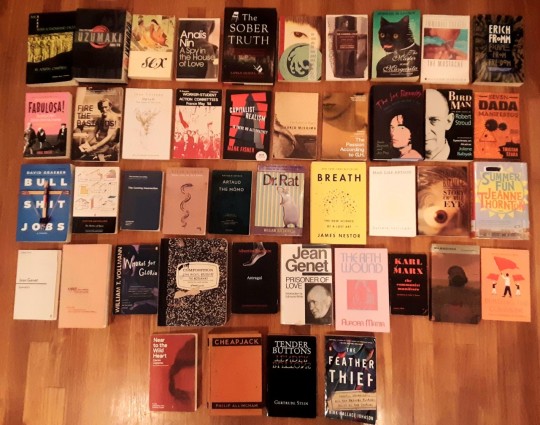
~Superlatives and Thoughts~
I read so many books this year I’m going to do a runner-up for each superlative category.
Favorite book: This is such a hard question this year. I think I gave out more five-star ratings on Goodreads this year than I ever have before. The books that got 5 stars from me this year were A Simple Story: The Last Malambo by Leila Guerriero, Capitalist Realism by Mark Fisher, The Emerald Mile by Kevin Fedarko, The Mustache by Emmanuel Carriere, The Passion According to GH by Clarice Lispector, trans girl suicide museum by Hannah Baer, The Fifth Wound by Aurora Mattia, Mammother by Zachary Schomburg, and Blackouts by Justin Torres. But I think my favorite book of the year was The Fifth Wound by Aurora Mattia. It is an embellished, fictionalized biography of the author’s life, chronicling a breakup that occurred just before she began her transition, and then a variety of emotional events afterward and her renewal of a connection with that person after a number of years had passed. The writing style is beautiful, extremely decadent, and sits in a sort of venn diagram of poetry, theory, fantasy and biography. My coworker who recommended this book to me said no one she’d recommended it to had finished it because they found it so weird. I read the first 14 pages very slowly because I didn’t exactly know what the book was doing, but I quickly fell completely in love with the imagery and the formatting style and the literary and religious references that have been worked into the book both as touchstones for biography and as vehicles for fantasy. There is a video I remember first seeing years ago, in which a beautiful pinkish corn snake slithers along a hoop that is part of a hanging mobile made of driftwood and macrame and white beads and prism crystals. This was the image that was in the back of my head the entire time I was reading The Fifth Wound, because it matched the decadence and the strangeness and the crystalline beauty of the language and visuals in the book. It is a pretty intense book, absolutely packed with images and emotion and ideas and preserved vignettes where reality and fantasy and theory overlap. It’s one of those books that’s hard to describe because it’s so full. It’s dense not in that the words or ideas are hard to understand, but in that it’s overflowing with imagery and feelings, and it feels like an overflowing treasure chest. Runner-up:The Mustache by Emmanuel Carriere. However, this book wins for a different superlative, so I’ve written more about it there.
Least favorite book: Querelle de Roberval by Kevin Lambert. I wrote a whole long review of it. In summary, Lambert’s book takes its name from Querelle de Brest, a novel by Jean Genet, and is apparently meant to be an homage to Genet’s work. Unfortunately, Lambert seems to misunderstand or ignore all the important aspects of Genet’s work that make it so compelling, and instead twists certain motifs Genet uses as symbols of love or transcendence into meaningless or negative connotations. He also attempts to use Genet’s mechanic of inserting the author into the narrative and allowing the author to have questionable or conflicting morals in order to emphasize certain aspects of the characters or narrative, except he does so too late in the game and ends up just completely undermining everything he writes. This book made me feel insulted on behalf of Jean Genet and all the philosophical thought he put into his work. Runner-up: What We See When We Read by Peter Mendelsund. This graphic designer claims that when people read they don’t actually imagine what characters look like and can’t conjure up an image in their head when asked something like ���What does Jane Eyre look like to you?” Unfortunately, there’s nothing scientific in the book to back this up and it’s mostly “I” statements, so it’s more like “What Peter Mendelsund Sees (Or Doesn’t See) When He Reads”. It’s written in what seems to be an attempt to mimic Marshall McLuhan’s style in The Medium Is The Massage, but it isn’t done very well. I spent most of my time reading this book thinking This does not reflect my experience when I read novels so I think really it’s just a bad book written by someone who maybe has some level of aphantasia or maybe is a visual but not literary person, and who assumes everyone else experiences the same thing when they read. (Another runner-up would be The Hero With A Thousand Faces by Joseph Campbell, but I think that’s a given because it’s an awful piece of revisionist, racist trash, so I won’t write a whole thing about it. I can if someone wants me to.)
Most surprising/unexpected book: The Mustache by Emmanuel Carriere. This book absolutely wins for most surprising. However, I don’t want to say too much about it because the biggest surprise is the end. It was the most shocking, most unexpected and bizarre endings to a novel I’ve read in a long time, and I absolutely loved it. It was weird from the start and it just kept getting weirder. The unnamed narrator decides, as a joke, to shave off the moustache he’s had for his entire adult life. When his wife doesn’t react, he assumes that she’s escalating their already-established tradition of little pranks between each other. But then their mutual friends say nothing about the change, and neither do his coworkers, and he starts spiral into confusion and paranoia. I don’t want to spoil anything else because this book absolutely blew me away with its weirdness and its existential dread and anyone who likes weird books should read it. Runner-up: Morvern Callar by Alan Warner. I don’t even know what compelled me to open this book at work, but I’m glad I did. The book opens on Christmas, where the main character, Morvern, discovers her boyfriend dead by suicide on the kitchen floor of their flat. Instead of calling the police or her family, she takes a shower, gets her things and leaves for work. Her narrative style is strange, simultaneously very detached and extremely emotional, but emotional in an abstract way, in which descriptions and words come out stilted or strangely constructed. The book becomes a narrative of Morvern’s attempts to find solitude and happiness, from the wilderness of Scotland to late night raves and beaches in an unnamed Mediterranean city. The entire book is scaffolded by a built-in playlist. Morvern’s narrative is punctuated throughout by accounts of exactly what she’s listening to on her Walkman. The narrative style and the playlist and the bizarre behavior of the main character were not at all what I was expecting when I opened the book, but I read the entire book in about 3 hours and I was captivated the whole time. If you like the Trainspotting series of books, I would recommend this one for sure.
Most fun book: The Emerald Mile by Kevin Fedarko. This book was amazing. It was like reading an adventure novel and a thriller and a book on conservationism all wrapped into one and it was clearly very passionately written and it was a blast. I picked it up because I was pricing it at work and I read the captions on one of the photo inserts, which intrigued me, so I read the first page, and then I couldn’t stop. The two main narratives in the book are the history of the Grand Canyon (more specifically the damming of the Colorado River) and the story of a Grand Canyon river guide called Kenton Grua, who decided with two of his river guide friends to break the world record for fastest boat ride down the Colorado River through the Grand Canyon. The book is thoroughly researched, and reaches back to the first written record of the canyon, then charts the history of the canyon and the river up to 1983 when Grua made his attempt to race down the river, and then the aftermath and what has happened to everyone in the years since. All of the historical figures as well as the “current” figures of 1983 come to life, and are passionately portrayed. It’s a genuine adventure of a book, and I highly recommend it. Runner-up: Summer Fun by Jeanne Thornton. It asks “What if Brian Wilson of the Beach Boys was actually a trans woman?” Actually, that’s not quite it. It asks “What if a trans woman living in poverty in southwest America believed to an almost spiritual level that Brian Wilson was a trans woman?” The main character and narrator, Gala, is convinced that the lead singer of her favorite band, the Get Happies, (a fictional but fairly obvious parallel to the Beach Boys) is a trans woman. Half the book is her writing out her version of the singer’s life history, and the other half is her life working at a hostel in Truth Or Consequences, New Mexico, where she meets a woman who forces her out of her comfort zone and encourages her to face certain aspects of her self and identity and her connection with others. It’s a weird novel, and definitely not for everyone, but it’s fun. I was reading it on the train home and I was so into it that I missed my stop and had to get off at the next station and wait 20 minutes for the train going back the other way.
Book that taught me the most: Breath: The new science of a lost art by James Nestor. In it, Nestor explores why humans as a general population are so bad at breathing properly. He interviews scientists and alternative/traditional health experts, archaeologists, historians and religious scholars. He uses himself as a guinea pig to experiment with different breathing techniques from ancient meditation styles to essentially overdosing on oxygen in a lab-controlled environment to literally plugging his nose shut to only mouth-breathe for two weeks (and then vice-versa with nose breathing). It was interesting to see a bunch of different theories a laid out together regarding what kind of breathing is best, as well as various theories on the history of human physiology and why breathing is hard. Some of it is scientific, some pseudoscience, some just ancient meditation techniques, but he takes a crack at them all. What was kind of cool is that he tries every theory and experiment with equal enthusiasm and doesn’t really seem to favor any one method. Since he’s experimenting on himself, a lot of it is about the effects the experiments had on him specifically and his experiences with different types of breathing. His major emphasis/takeaway is that focusing on breathing and learning to change the ways in which we breathe will be beneficial in the long run (and that we should all breath through our noses more). While I don’t think changing how you breathe is a cure-all (some of the pseudoscience he looks at in this book claims so) I certainly agree that learning how to breath better is a positive goal. Runner-up: The Sober Truth by Lance Dodes. I say runner-up because a lot of the content of the book is things that I had sort of vague assumptions about based on my knowledge of addiction and AA and mental illness in general. But Dodes put into words and illustrated with numbers and anecdotes and case studies what I just kind of had a vague feeling about. It was cool to see AA so thoroughly debunked by an actual psychiatrist and in such a methodical way, since my skepticism about it has mostly been based on the experiences of people I know in real life, anecdotes I’ve read online, or musicians/writers/etc I’m a fan of that went through it and were negatively affected.
Most interesting/thought provoking book: Mammother by Zachary Schomburg. The biggest reason this book was so interesting is because the little world in which it exists is so strange and yet so utterly complete. In a town called Pie Time (where birds don’t exist and the main form of work is at the beer-and-cigarettes factory) a young boy called Mano who has been living his childhood as a girl decides that he is now a man and that it’s time for him to grow up. As this happens, the town is struck by an affliction called God’s Finger. People die seemingly out of nowhere, from a hole in their chest, and some object comes out of the hole. Mano collects the things that come out of these holes, and literally holds them in order to love them, but the more he collects, the bigger he becomes as he adds objects to his body. A capitalist business called XO shows up, trying to convince the people of Pie Time that they can protect themselves from God’s Finger with a number of enterprises, and starts to slowly take over the town. But Mano doesn’t believe death is something that should be run from. This book is so pretty, and the symbolism/metaphors, even when obvious, feel as though they belong organically in the world. A quote on the back of the book says it is “as nearly complete a world as can be”, and I think that’s a very accurate description. The story is interesting, the characters are compelling, and the magical realist world in which the story exists is fascinating. Runner up: trans girl suicide museum by Hannah Baer. This is a series of essays taken (for the most part) from Baer’s blog posts. They span a chunk of time in which she writes her thoughts and musings on her experience transition and transgender existence in general. It is mostly a series of pieces reflecting on “early” stages of transition. But I thought it was really cool to see an intellectual and somewhat philosophical take on transition, written by someone who has only been publicly out for a few years, and therefore is looking at certain experiences with a fresh gaze. As the title suggests, a lot of the book is a bit sad, but it’s not all doom and gloom. A lot of the emphasis is on the important of community when it comes to the experience of starting to transition and the first few years, and the importance of community on the trans experience in general. I really liked reading Hannah Baer’s thoughts as a queer intellectual who was writing about this stuff as she experienced it (or not too long after) rather than writing about the experience of early transition years and years down the line. It meant the writing was very sharp and the emotion was clear and not clouded by nostalgia.
Other thoughts/commentary on books I don’t have superlatives for:
I’m glad my first (full) book read in 2023 was A Simple Story: The Last Malambo by Leila Guierrero. It’s a small, compact gem of a book that follows the winner of an Argentinian dance competition. The Malambo is a traditional dance, and the competition is very fierce, and once someone wins, they can never compete again. The author follows the runner-up of the previous year, who has come to compete again. It paints a vivid picture of the history of the dance, the culture of the competition, and the character of the dancer the author has chosen to follow. It’s very narrowly focused, which makes it really compelling.
The Hearing Trumpet by Leonora Carrington could have easily won for most fun or most interesting book. Carrington was a surrealist writer and painter (and was in a relationship with Max Ernst until she was institutionalized and he was deported by the Nazis). In The Hearing Trumpet, an elderly woman called Marian is forced by her family to go live in an old ladies’ home. The first strange thing about the place is that all of the little cabins each woman lives in is shaped like some odd object, like an iron, or ice cream, or a rabbit. The other old women at the institution are a mixed bag, and the warden of the place is hostile. Marian starts to suspect that there are secrets, and even witchcraft involved, and she and a few of the other ladies start to try and unravel the occult mysteries hidden in the grounds of the home. The whole book is fun and strange, and the ending is an extremely entertaining display of feminist occult surrealism.
Sacred Sex: Erotica writings from the religions of the world by Robert Bates was a book I had to read for research for my debunking of Withdrawn Traces. It was really very interesting, but it was also hilarious to read because maybe 5% of any of the texts included were actually erotic. It should have been called “romantic writings from the religions of the world” because so little of the writing had anything to do with sex, even in a more metaphorical sense.
Every time I read Yukio Mishima I’m reminded how much I love his style. The Sailor Who Fell From Grace With The Sea almost usurped The Temple of the Golden Pavilion as my favorite Mishima novel. I’m fascinated with the way that Mishima uses his characters to explore the circumstance of having very intense feelings or reactions towards something and simultaneously wanting to experience that, while also wanting to have complete control and not feel them at all. There’s a scene in this novel where Noboru and his friends brutally kill and dissect a cat; it’s an intense and vividly rendered scene, made all the more intense by Noboru desperately conflicted between feeling affected by the killing and wanting to force himself to feel nothing. The amazing subtle theme running through the book is the difference between Noboru’s intense emotions and his desire/struggle to control them and subdue them versus Ryuji’s more subtle emotion that grows through the book despite his natural reserve. I love endings like the one in this book, where it “cuts to black” and you don’t actually see the final act, it’s simply implied.
In 2016 or 2017, I ran lights for a showcase for the drama department at UPS (I can’t remember now what it was) that included a bunch of scenes from various plays. I remember a segment from Hir by Taylor Mac, and a scene from The Aliens by Annie Baker. In the scene that I saw, one of the characters describes how when he was a boy, he couldn’t stop saying the word ladder, and the monologue culminates in a full paragraph that is just the word “ladder.” I can’t remember who was acting in the one that I saw at UPS, but that monologue blew me away, the way that one word repeated 127 conveyed so much. This year a collection of Annie Baker’s plays came in at work so I sat down and read the whole play and it was just incredible. I’d love to see the full play live, it’s absolutely captivating.
Narrow Rooms by James Purdy was a total diamond in the rough. It takes place in Appalachia, in perhaps the 1950s although it’s somewhat hard to tell. It follows the strange gay entanglement between four adult men in their 20s, who have known each other all their lives. It traces threads of bizarre codependency, and the lines crossed between love and hate. The main character, Sidney, has just returned home after serving a sentence for manslaughter. On his return, he finds that an old lover has been rendered disabled in an accident, and that an old school rival/object of obsession has been waiting for him. This rival, nicknamed “The Renderer” because of an old family occupation, has been watching Sidney all their lives. Both of them hate the other, but know that they’re destined to meet in some way. Caught in the middle of their strange relationship are Gareth, Sidney’s now-disabled former lover, and Brian, a young man who thinks he’s in love with The Renderer. The writing style took me some time to get used to, as it is written as though by someone who has taught themselves, or has only had basic classes on fiction writing. But the plot itself is so strange and the characters are so stilted in their own internality that it actually fits really well. Like The Mustache, this book had one of the strangest, most intensely visceral and shocking endings I’ve read in a while. It was also “one that got away.” I read it at work, then put it on my staff picks shelf, and only realized after someone else bought it that I should have kept it for myself.
The Passion According to G.H. by Clarice Lispector blew my mind. I really don’t want to spoil any of it, but I highly encourage anyone who hasn’t read it to do. The build in tension is perfect and last 30 pages are just incredible. Lispector’s style is so unique and so beautiful and tosses out huge existential questions like it’s nothing, and I love her work so much.
Moscow To The End Of The Line by Venedikt Erofeev was another really unexpected book. It’s extremely Russian (obviously) and really fun until suddenly it isn’t. The main character, a drunkard, gets on a train from Moscow to Petushki, the town at the end of the line (hence the title), in order to see his lover. On the way, he befriends the other people in his train car and they all steadily get drunker and drunker, until he falls asleep and misses his stop. Very Russian, somewhat strange, and I was surprised that it was written in the late 60s and not the 30s.
Dr. Rat by William Kotzwinkle was what I expected. Weird in a goofy way, a bit silly even when it’s serious, and rather heavy-handed satire. The titular Dr Rat is a rat who has spent his whole life in a laboratory and has gone insane. The other animals who are being tested on want to escape, but he’s convinced that all the testing is for the good of science and wants to thwart their rebellion. Unfortunately, all the other animals who are victims of human cruelty/callousness/invasion/deforestation/etc around the world are also planning to rebel, connection with each other through a sort of psychic television network. It’s a very heavy-handed environmentalist/anti-animal cruelty metaphor and general societal satire, but it’s silly and fun too.
Confessions Of A Part-Time Lady by Minette is a self-published, nearly impossible to find book that came into my work. It’s self-printed and bound, and was published in the 70s. It is the autobiographical narrative of a trans woman who did drag and burlesque and theatre work all across the midwest, as well as New York and San Francisco, from the 1930s up to the late 60s. It was originally a series of interviews by the two editors, who published it in narrative form, and it includes photos from Minette’s personal collection. It’s an amazing story, and a glimpse into a really unique time period of gender performance and queer life. She even mentions Sylvia Rivera, specifically when talking about gay activism. She talks about how the original group of the Gay Liberation Front was an eclectic mix of all sorts of people of all sexualities and genders and expressions. Then when the Gay Activists Alliance “took over”, they started pushing out people who were queer in a more transgressive or unusual way and there was more encouragement on being more heteronormative. She mentions Sylvia Rivera and Marsha P Johnson, saying “I remember Sylvia Rivera who founded STAR – Street Transvestite Action Revolutionaries. She was always trying to say things – the same kinds of things Marsha P Johnson says in a sweeter way – and they treated her like garbage. If that’s what ‘order’ is, haven’t we had enough?”
Whores For Gloria by William T Vollmann was exactly as amazing as I thought it would be. I love Vollmann’s style, because you can tell that even though the characters he’s writing about are characters, they’re absolutely based on people that he met or saw or spoke to in real life. The main character, Jimmy, is searching for his former lover, Gloria, who has either died or left him (it is unclear for most of the novel). He begins to use tokens bought from sex workers (hair, clothes, etc) to attempt to conjure her into reality, and when that doesn’t work, he pays them to tell him stories from their lives, and through their lives he tries to conjure Gloria. This novel’s ending had extremely similar vibes to the ending of Moscow To The End Of The Line.
Prisoner Of Love by Jean Genet was a lot to take in. It was weird reading it at this moment in time, and completely unplanned. It’s just that I have only a few more books to read before I’ve made my way through all Genet’s works that have been translated into English, and it was next on the list. Most of the book focuses on Genet’s time spent in Palestine in the 70s and his short return in the 80s. He also discusses the time he spent with the Black Panthers in the US, although it’s not the main subject of the book. Viewing Palestine from the point of view of Genet’s weird philosophical and moral worldview was really interesting, because what he chooses to spend time looking at or talking about is probably not what most would focus on, and because even his most political discussions are tinged with the uniquely Genet-style spirituality (if you can call it that? I don’t know what to call it) that is so much the exact opposite of objective. It’s definitely not a book about Palestine I would recommend reading without also having a grasp of Genet’s style of looking at the world and his various obsessions and preoccupations, because they really do inform a lot of his commentary. It was also written 15 years after his first trip to Palestine, partly from memory and partly from journal entries/notes, which gives it a sort of weirdly dreamlike quality much like his novels.
Blackouts by Justin Torres was so amazing! It blends real life and fiction together so well that I didn’t even realize that most of the people he references in the novel are real historical figures until he mentioned Ben Reitman, who I recognized as the Chicago King Of The Hobos and Emma Goldman’s lover. The book follows an unnamed narrator who has come to a hotel or apartment in the southwest in order to care for a dying elderly man called Juan Gay. Juan has a book called Sex Variants, a study of homosexuality from the 1940s which has been censored and blacked out. Back and forth, the narrator and Juan trade stories. The narrator tells his life story up until the present, including his first meeting with Juan in a mental hospital as a teenager. In turn, Juan tells the story of the Sex Variants book and its creator, Jan Gay (Ben Reitman’s real life daughter). The book explores the reliability of narrative, the power of collecting and documenting life stories, and of removing or changing things in order to create new or different narratives.
Again, Clarice Lispector rocking my world! Generally I can read a 200-ish page novel in somewhere between 2 and 4 hours depending on the content/writing style. Near To The Wild Heart took me 9 hours to read because I kept wanting to stop and reread entire paragraphs because they were so interesting or pretty or philosophical. The story focuses on Joana, whose strange way of looking at the world and going through life makes everyone sort of wary of her. This book is so layered I don’t really know how to describe it. So much of it is philosophical or existential musings through the vehicle of Joana. Unsurprisingly, it’s a beautiful book and I highly recommend it.
I’m just going to copy/paste my Goodreads review for Skye Papers by Jamika Ajalon: This book had so much potential that just…fell short. I could tell that it was written for an American audience but the way the reader/Skye is “taught” certain British terms and/or slang felt a bit patronizing. The characters were fleshed out and interesting and I liked them a lot but the plot crumbled quickly in the last half of the book Things sped up to a degree that felt strange and unnatural, the book’s pacing was inconsistent throughout. Perhaps that was deliberate considering the reveal at the climax, but if it was, it should have been utilized better. If the inconsistent pacing wasn’t deliberate, then it just made the book feel strange to read. There were moments were I felt like there should have been more fleshing out of certain character relationships. Even with the reveal at the end and the explanation of Pieces’ erratic/avoidant behavior, I wish there had been more fleshing out of the relationship or friendship between her and Skye at the beginning, when Skye first arrives in London. Characters who seemed cool/interesting got glossed over and instead there was a lot more dwelling on Skye walking around or busking or just hanging out. I could have gone without the last 30 or so pages after the big reveal, where Skye went back through everything that happened with the knowledge she (and the reader) had gained. It dragged on and on and at that point I felt like the whole story was so contrived that I just wasn’t interested anymore. A friend who read this book before I did said she thought it was an experimental novel that just hadn’t gone far enough, and I completely agree with her. I think if the style with the film script interludes went further, into printed visuals or more weirdness with the interludes, more experimental style with the main story, or something, it would have been really good. It just didn’t push hard enough.
The Feather Thief by Kirk Wallace Johnson was a fun little true crime novel about a young flautist who broke into a small English natural history museum in 2009 and stole hundreds of thousands of pounds worth of preserved rare bird skins dating back to the 19th century. He was a salmon fly-tying enthusiast and prodigy, and old Victorian fly designs used feathers of rare birds. The book first goes through the heist and the judicial proceedings, then examines the niche culture of Victorian fly-tying enthusiasts and obsessives, and then chronicles the author’s attempts to track down some of the missing birds. It was a quick, easy read, but fun and an unusual subject and I quite enjoyed it.
In 2024 I don’t plan on trying to surpass or even reach this year’s number. I’m going to start off the year reading The Recognitions by William Gaddis, then I’m going to re-read a number of books that I come across at work or in conversation and think Huh, I should reread that one of these days. So far, the books I am currently planning to reread: Sometimes A Great Notion by Ken Kesey, As I Lay Dying by William Faulkner, The People Of Paper by Salvador Plascencia, Mrs Dalloway by Virginia Woolf, The Mustache by Emmanuel Carriere, McGlue by Otessa Moshfegh, Long Day’s Journey Into Night by Eugene O’Neil, Acid Snow by Larry Mitchell, and Nightwood by Djuna Barnes.
#reading list#book list#book roundup#reading list year in review#books#squash rambles#reading year in review#book list roundup
6 notes
·
View notes
Text

Tad the lost explorer and the crystal’s odyssey cast
@jakkiisthatboy2
Main Voices:
Tad: Trevor white
Sara: Alex Kelly
Mummy: Joseph Balderrama
Tiffany maze: Gemma whelan
Ramona: Pippa Bennett Warner
Victoria: Elena Sanz
Ramirez: Elena suarel
Amy Jefferson Stones: Auli’i Cravalho
Jasmine Jefferson Stones: Anya Taylor-Joy
Reena Roberto Ramirez: Olivia Rodrigo
Lukas Williams: Patton oswalt
Flora peace: Ariana grande
Minnie wakanda: Kiki Layne
Snowy Moscow: Taylor swift
Jessie wakins: Tiffany haddish
Kelsey swells: Ariel Winter
Chai Ming Kong: akwafina
Nagham hugh: beyonce
Roger: Roger Craig smith
Kenny: Ken jeong
Christopher: Chris Pratt
Kevin: Kevin hart
Jeremy: John Leguizamo
Dagenia: Moses Ingram
Oganda: Danai Gurria
Liza: Letitia wright
Jaiden: Max Charles
Young Jaiden: Shelby young
Indiana Jones: Dustin Hoffman
Tiffany mordon: Sheila Victor
Blair: dove Cameron
Ying: Constance Wu
Andrea: Christina Vee
Riña: Brittney spears
Max: Adam James
Jack: Ramon tikaram
Pickles: Gary Martin
Selena Stones: Geraldine Viswanathan
Taila Stones: Jenna ortega
Singing:
Tad: ZAYN
Sara: Tori Kelly
Mummy: Joseph Balderrama
Tiffany maze: Taylor swift
Ramona: Bebe wood
Victoria: auli’i Cravalho
Ramírez: auli’i Cravalho
Reena: Olivia Rodrigo
Lukas: Justin Bieber
Anne: Philpha Alexander
Tiffany mordon: Renee Rapp
Riña: Brittney spears
Max mordon: Adam James
Blair: dove Cameron
Ying: Constance wu
Andrea: Christina Vee
Jasmine: Tori Kelly
Amy: auli’i Cravalho
Other voices:
Michael Jefferson: Ray Romano
Anderson: Josh Gad
Joe: Nicholas cage
Ryu: Ed guaghan
Brian: Ben cura
Professor Lavoff: Jim Carter
Katie peace: Leslie Mann
Josh rackham peace: Peter Dinklage
Minnie’s mother: Queen Latifah
Nala: Lupita nyong’o
Jax wakins: Will Smith
Angelica wakins: Anika noni rose
Mary: Jennifer Lopez
Jacob: Jason Sudeikis
Riley: Madison Polan
Jess: Carrie Kearnen
Mark: Zac effron
John: Raymond Ochoa
Kohl: Jason Segel
Kanji: Michael cena
Grandpa Lu mian: Dustin Hoffman
Grandma Jie mei: Lucy Liu
Charlotte: Selena Gomez
Ronald: Robert De Niro
Jackie: Kristen bell
Joe: Davis Cross
Mika: khalessi lambert tsuda
Lin Jung: simu liu
Regina: Issa Rae
Messiah: Eddie Murphy
Miracle: Nicki Minaj
Emily: Zoe Perry
George: lance barber
News reporter: Keegan Michael key
Margie: Lani Minella
Song list:
Do what you gotta do: dove Cameron: (max’s and Reena’s argument)
What was I made for: Billie Ellish (the mind of memories form first to third film)
Perfect people: Becky hill (mummy’s capture)
Stuck with you: Ariana grande and Justin Bieber (Reena and Lukas’s love song)
World burn: Renee Rapp (Tiffany’s revenge)
Hold on: Becky hill (the gang continues on their journey)
World burn: Renee Rapp (Tiffany mordons villain song; she starts making everyone mean using her powers; her revenge on tad)
A different beat: little mix;(the Chicago cats kahoot challenge course)
Respectless: (Reena stands up to pickles)
Courage in me: Lou (Tad’s transformation)
Lazarus drug: (epilogue song)
A wish worth making: (end credits)
Empire: Ella Henderson ( playing in the background when end credits rolling)
2 notes
·
View notes
Text
Leaving it all behind song recs
I made a list of all the song recs from Leaving it all Behind, idk if anyone has done this (someone probably has) but i cant be bothered to see if someone has so here it is. Leaving it all Behind Way Down We Go - KALEO Bitter End - Rag’n’Bone One Thing Right (Instrumental) - Piano Dreamers. Lilium (Ellen Lied) - Grissini Project Lay My Body Down - Rag’n’Bone Man One - Metallica Fake it - Seether Shallow - Garth Brooks and Trisha Yearwood Astronaut In The Ocean (Alok Remix) - Masked Wolf. “Going the Distance” from Hercules Lovely – Billie Eilish & Khalid All Around Me – Flyleaf Ocean eyes – Billie Friend Like Me - Betty Who Till It’s Gone - Yelawolf Skin - Rag’N’Bone. We Will Rise Again (feat. Meredith Godreau) – Dan Romer 7 years – Daniel Jang Take on the World - You Me At Six Risking it All Winterwolf - BrunuhVille Stokkseyri - Jónsi & Alex Become the Beast - Karliene Say My Name - Ólafur Arnalds Run - Ludovico Einaudi Threnody - Goldmund Walked Through Hell - Anson Seabra All I’ve Got - Rüfüs Du Sol Come Away to the Water - Maroon 5 Next To You - Little Big Town Song of the Abyss - Aviators Bad Habits - Ed Sheeran July - Noah Cyrus 39 Seconds & Tokyo Rain - Marcus Warner Wolfborn - BrunuhVille NFWMB - Hozier Male Fantasy - Billie Eilish Into The West - Peter Hollens NFWMB - Hozier Become The Beast - Karliene (I listened to this A LOT) Snake Eyes - Mumford & Sons Watch The World Die - Cody Jinks sum of our parts - mary lambert invincible - adelitas way Heat Waves - Harrison Running up that hill - Kate Bush Pieces by Rob Thomas Sunny side of summer - Bobs burgers movie Love is not dying - Jeremy zucker Little dark age - MGMT Take it all back - Judah & The Lion Sedated - Hozier This Place is a Shelter - Olafur Arnalds Experience - Angèle Dubeau and La Pieta Run - I Virtuosi Italiani and Ludovico Einaudi something in orange - Zach Bryan running away (acoustic version) - Hoobastank everything - Lifehouse Into the Fire Good To Be Alive - PVRIS Mad World - Gary Jules Tokyo Rain - Marcus Warner Don’t Blame Me - Taylor Swift Good to Be Alive - PVRIS Save Me - Jelly Roll Bells in Santa Fe - Halsey Lay My Body Down - Rag’n’Bone Man Gasoline - Halsey Song of the Abyss - Aviators Ghost - Badflower Falling Up - Dean Lewis
10 notes
·
View notes
Text
Mortal Kombat (My spellchecker is gonna kommit suicide by the end of this), Part 1
youtube
(Thanks to Rotten Tomatoes)
[All images are owned by Midway Games NetherRealm Studios and New Line Cinema Warner Bros Discovery. Please don’t sue me or deliver a fatality]
(QUICK NOTE: If the header of this review isn’t enough of a klue, I will be writing this in the style of the game (sorta), which means words that begin with a certain phonetic sound with be spelled...differently. And if you find it hard to read, imagine how hard it was to write!)
In 1992 in arcades across America (and likely other kountries, but I’ve never been to any of them so kan’t konfirm) a game appeared that changed the arcade game dynamic for years to kome. That game, of kourse, was Mortal Kombat.
The plot of the game (such as it was) involved a deadly pit fighting tournament known as Mortal Kombat (naturally) where the heroes of Earth face off against the kombatants of a realm known as Outworld, led by the sorcerer Shang Tsung, the right hand of Outworld’s emperor Shao Kahn (and also presided over the tournament and was the Final Boss, so there wasn’t any konflict of interest or anything)
It wasn’t the graphics, though they were as realistic as 1992 kould make them. It wasn’t the gameplay; it was a fairly standard fighting game in that respect. No, what set the game apart (and sent parents groups nationwide into a frenzy) was how graphic it was.
youtube
(Thanks to Kraig...err, Craig Steelyard)
However, the game was popular enough that New Line Cinema made a movie about it three years later that featured all of the karacters from the first game (plus a few from the second in kameos). Now, a movie based on video games was a very new koncept (there were only 2 released before Mortal Kombat) and it wasn’t until 2019 that kritics thought a video game movie was "fresh” (over 60% positive reviews), but just because the kritics panned it (only 45% liked it) doesn’t mean it wasn’t fun.
So let’s see how they turned one of the most graphically violent video game franchises of the 90s into a PG-13 film. If you would like to watch the film, it’s available with a Max subscription or you can find it behind your favorite paywall.
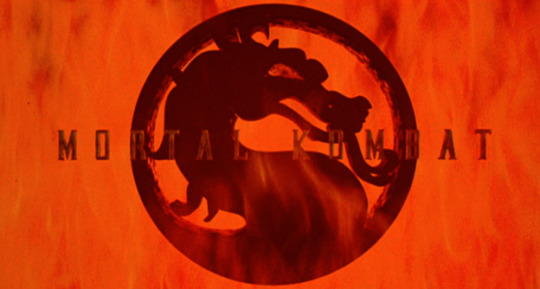
We open at a temple in China where a monk named Chan Kang is konfronted by…
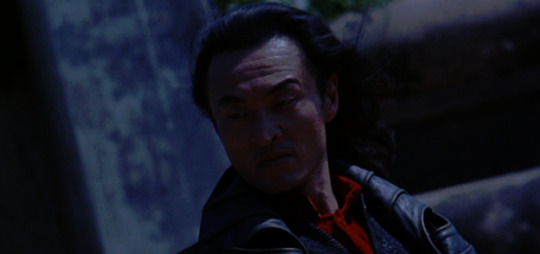
…Shang Tsung, who makes short work of him and konsumes his soul (yeah, that’s kinda Shang’s Thing) as he screams for his brother…

…Liu Kang, who wakes up in a kold sweat. He receives word that Chan is dead and to return to China (he’s kurrently somewhere in the US)
Meanwhile in Hong Kong…
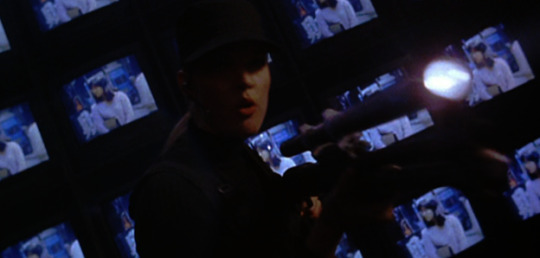
Lt. Sonya Blade (leader of an unspecified US agency strike team) is preparing an assault on…
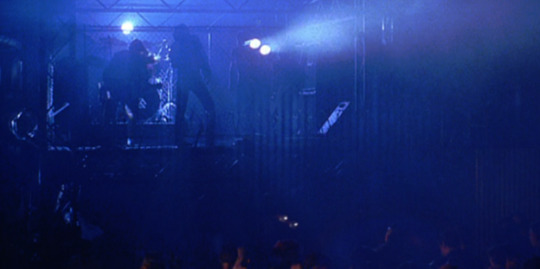
…an underground koncert? Anyway, she and her team bash their way through the krowd looking for…

…the krime lord known as Kano, who is in kahoots with Shang Tsung. Shang Tsung has manipulated events such that Sonya will follow Kano onto the boat bound for the Mortal Kombat tournament, with a warning that Sonya must reach the tournament unharmed.
Elsewhere in a nondescript warehouse in Los Angeles…
youtube
(Thanks to Fandango)
No sooner does Johnny Cage (how kome his last name starts with a “C”?) leave then “Master Boyd” changes form into…
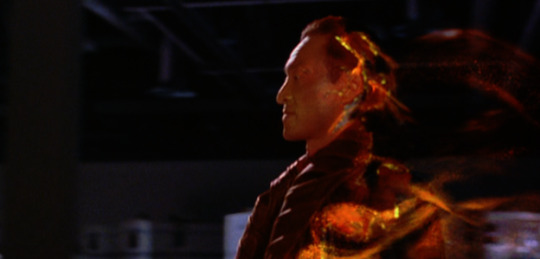
So Shang Tsung is backhandedly recruiting the kombatants who will oppose him? Why would he do that?
Later at the temple, Lui has kome home to discover that Chan was to participate in Mortal Kombat when Liu left the temple. Suddenly, he decides he will enter Mortal Kombat to avenge Chan. Then the temple gets a visit from…
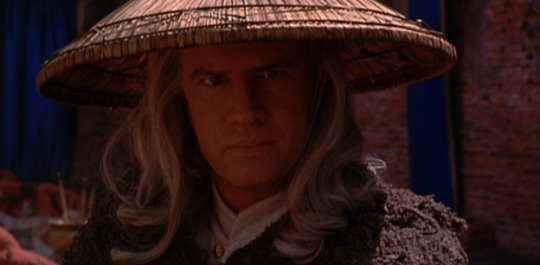
…Lord Raiden, God of Thunder and Lightning (played by Kristopher…err, Christopher Lambert, who speaks with a French accent despite playing a Chinese god)
[FUN FACT: Lambert is very nearly blind. In fact, he was doing all of his swordplay in the Highlander films when he kould barely see!]
Raiden questions Lui’s kommitment (revenge vs. saving the world), but Lui storms off to katch the boat to the tournament. Raiden doesn’t like this…

[NOTE: in the games Raiden is a playable karacter, but in the movie he’s little more than a koach]
That evening at a seedy pier in Hong Kong, Johnny and Liu arrive but start on the wrong foot (Johnny tries paying Lui to bring his luggage on the boat, so Lui throws Johnny’s luggage into the bay)

Meanwhile Sonya is staking out the pier with her partner Jackson “Jax” Briggs (one of the karacters from the second game) in search of Kano when...

…an ominous-looking junk (I’m not kasting shade on the quality of the kraft. That’s what those types of boats are kalled) enters the bay. Sonya spots Kano boarding and immediately rushes aboard without backup. She immediately runs into Johnny (literally)…
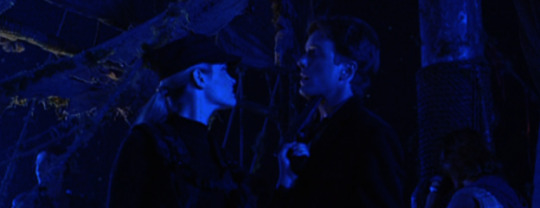
…and they get along swimmingly. I’m starting to think Johnny isn’t exactly a people person.
Sonya goes below deck, where she runs into Shang Tsung. Johnny and Liu kome down for support (for some reason)
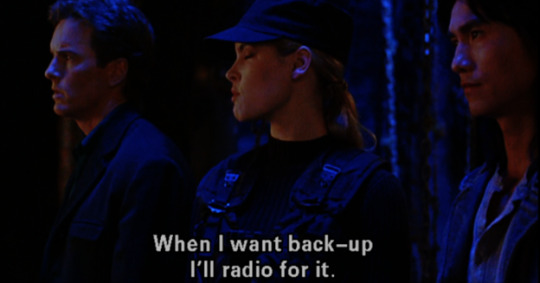
Pretty much.
Then we get the appearance of the last two playable karacters from the game…

Sub-Zero

and Scorpion
(Fun Fact for those who have not played the game: later versions of the game had an increasing number of ninja dressed like Sub-Zero and Scorpion. The reason is obvious: a quick kolor change and a kouple of unique special moves and it’s a whole new karacter! They saved a ton on graphics and koding kosts!)
Shang Tsung brags that he has full kontrol over the two, despite their being mortal enemies. Sonya draws her weapon on them, but Sub-Zero…
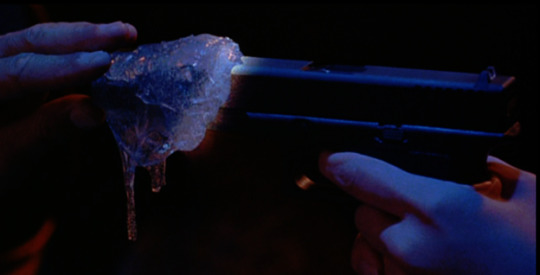
…yeah (that’s kinda his thing in the game)
Meanwhile, Scorpion…
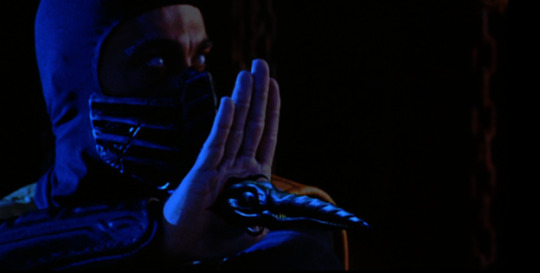
OK, in the game, Scorpion shoots a barbed line at his opponent from…somewhere (“GET OVER HERE!”) This take on the line is both kooler and WAY kreepier!
Then a ball of lightning appears in the hold and morphs into…
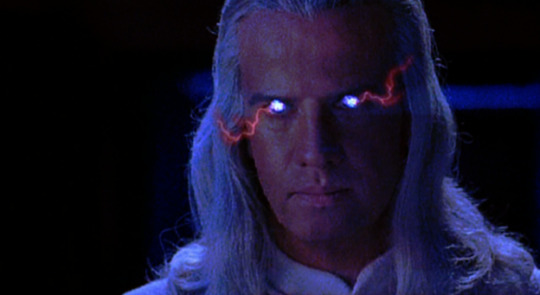
Raiden reminds Shang Tsung that the tournament hasn’t started yet and tells him to bring his attack dogs to heel.
Of course, this is the first time Sonya has heard she’s in a tournament and isn’t too happy about it. Raiden then explains to the three what’s at stake.

After Raiden has info-dumped the importance of Mortal Kombat (and why, out of the dozens of others on the junk, they are the Chosen Ones)…
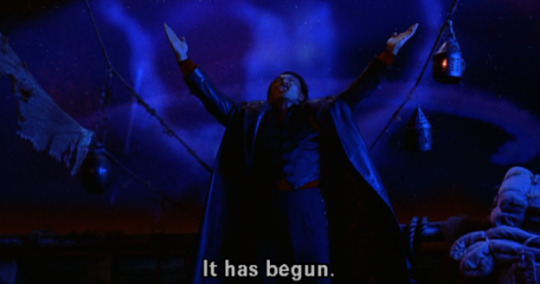
…we are treated to bad special effects, announcing the arrival to the tournament.
What dangers await the Heroes of EarthRealm? Check out Part 2 and find out!
2 notes
·
View notes
Video
Mortal Kombat 11 - Shang Tsung,Night Wolf,Terminator T-800,Sindel,Joker,...
Mortal Kombat 11 is a fighting video game developed by NetherRealm Studios and published by Warner Bros. Interactive Entertainment on PlayStation 4, Xbox One, Nintendo Switch and PC. It is the eleventh installment in the Mortal Kombat series and the sequel to Mortal Kombat X. The game was released on April 23, 2019 for Playstation 4 and Xbox One. It releases May 9 on Nintendo Switch. In October 2020, it is announced that the game will be entitled to a Playstation 5 version as well as Xbox Series under the name of Mortal Kombat 11 Ultimate. Kombat Pack #1 notably added Spawn, a character from the comic book publisher Image Comics created by Todd McFarlane, the Joker, a character from the comic book publisher DC Comics and The T-800 from the Terminator3 films. Keith David once again plays Spawn 20 years after the end of the animated series Todd McFarlane's Spawn (1997-1999). The Joker is portrayed by Richard Epcar, who also voices him in Mortal Kombat vs. DC Universe (2008) and Injustice games (2013-2017). As for the T-800, if he retains the features of Arnold Schwarzenegger, his voice is that of comedian Chris Cox (in) in the game3. The game marks the historic return of Christophe Lambert, twenty-five after the first Mortal Kombat film. The pack also marks the return of Cary-Hiroyuki Tagawa who takes over the role of Shang Tsung after the 1995 film Mortal Kombat and the second season of Mortal Kombat: Legacy in 2013. As for the T-800, if he retains the traits of 'Arnold Schwarzenegger, his voice is that of comedian Chris Cox in game 3. The game marks the historic return of Christophe Lambert, twenty-five after the first Mortal Kombat film. The pack also marks the return of Cary-Hiroyuki Tagawa who takes over the role of Shang Tsung after the 1995 film Mortal Kombat and the second season of Mortal Kombat: Legacy in 2013. The Aftermath pack notably adds the character of Alex Murphy / RoboCop, played by Peter Weller thirty years after the movie RoboCop 2 released in 1990. The pack also adds Fujin and Sheeva, played by Matthew Yang King and Vanessa Marshall respectively. The Kombat Pack 2 notably adds the character of John Rambo, played once again by Sylvester Stallone who plays the role in the five Rambo films between 1982 and 2019, i.e. thirty-seven years. The pack also adds Mileena and Rain, played by Kari Wahlgren and Dempsey Pappion respectively. Released on November 24, 2020, the Klassic MK Movie Pack includes new appearances for Raiden, Johnny Cage and Sonya Blade, using the voices and appearance of Christophe Lambert, Linden Ashby and Bridgette Wilson, who voiced the characters in the Mortal movie 1995 fight.
#youtube#mortalkombat11gameplay#mortalkombat11indonesia#shangtsungmkmobile#nightwolf98#spawn#spawncamping#pcgames#pc games#gamers#gamaes#ps#ps5#ps4#xbox#xbox series x#xobox series s#video youtube#new video youtube
2 notes
·
View notes
Text
Notes
I have been enemy de-resourced and several accounts hacked. My iCloud account, has been compromised. When arrested at Portland State at a computer terminal: I was logged into my Apple Acct: which was during a hostile corporate takeover. This is when all my iTunes disappeared, and Miranda Lambert's shit popped up on it: a whole album or two.
My equipment was never returned to me. My cousin's jewlery that was found was never returned either. We will most likely have to kill every officer I emailed @PDX.edu. The stupid blonde one who thought she was human is still crying that I dug the heel of my boots into her shins.
I am sure I can find them in an internet preserved v-card somewhere. Most emails that that have nixed: have been attached to the same vcard and equipment I was mugged for when I first hit the city of Portland. Most of this, was on Gale Loyd's behalf: who is frequently confused for Gayle Luinstra (Gael L.) in case file folders. Both, are blond mamasitas who need to go back to managing their vaginas properly and learn to keep their vaginas to themselves.
My 'Gina, the little mohawk lady downtown somewhere south of near 5th avenue, the bitch downstairs doesn't seem to be amused at not no the moment. I still seem to be getting sued or something for listening to a free iTune. It was Sharon Van Etton or something. Maybe I am just in trouble for having three Sharons, two of them named Sharon Z.
I'm in the middle of charging my flashlight. It's a rayovac that requires a micro USB cord. The two micro-motherboards in it suggest that it could be used to open up networks. I donno. Its enough to make me paranoid. My mother's ring, I decided not to wear today. I am starting to suspect it's haunted. I seem to take on her persona and exhibit signs of demonic possession when wearing it.
My mother, was always arguably more satanic & demonic than myself. Me? I am just sardonic, which is considered to be a positive trait among my people in my home small town. Most of them: are bight wonderful chipper happy people, perfectly genius: however they're mostly "THOSE" kind of people... Persons with twisted knotted features who get called witches and demons easily.
That reminds me...
Non-Human persons are losing their personage. Which means they can be blatantly and rudely slave driven under current law and statures. When and where reefer (the devil's weed) is mentioned: feudal law takes over and whomever has the largest gun is who is to decide what law is and is not. 4-20, the lingo for legalization of pot, has nothing to do really with smoking weed. It's an integral part of the 14-88/Aryan brotherhood conspiracies to kill, incarserate, or slave drive every last "undesirable" which frequently includes midgets, homos, muslims, kurds, negros bred for heavy lifting, negros bred white and magical voodoo creatures from Persia and Hindustan like Alka. Even the blonde ones.
That reminds me: send someone to buy Alka Joshi. Too, tell she... "woman, spread yo legs while your man picks my cotton."
Could someone please slap Marquese Evans?
Tell he that he black ass life do not never not no matter. Nor do the lives of anyone black he ever did meet. Then tell he... tell he...
Tell he to go farm my tobacco. I want toilet paper made out of tobacco leaf. This way, the toilet paper in prison can be smoked. The paper would be naturally anti-bacterial and anti-microbial so as there's no bugs crawling on not nobody's ass in juvie, and its more environmentally minded than cutting down every last tree in the forest.
Oh & slap Aunt Marilyn too. Just for assuming I would want anything to do with Warner Brothers. I'm more interested in protecting stock in Lambert Pharm, which has heavily taken to Australia due to the massacres in North America. Serial killers in the South Pacific have traded locations with those here in the USA. So, we are praying for the ilk of "Nun With Kitty" who was in a BBC show about Cats in New Zealand. She has a "brother" who was in Portland. Probably Naval or some form of military. Human. Obviously black irish of Gaul. Lo sissy a giovichaun be: not born of Seelie and perhaps at all times at race war with the whole lot of us here in Kansas. You know, being Lebeaus, Luinstras, Lamberts, Lambros, Lucifers, with the Seelies, Seelys, etc sitting there being niggers like they where Pepper Spice.
We had to alert him & they of everyone's presence.
Hopefully nobody was killed who was serving split pea soup downtown under the glass ceiling. Hopefully nobody WHITE was killed anyway. Something tells me my mother is dead and haunting her maternity band. One of them, was a babysitter of mine from Denver or Berthod or somewhere.
I wonder if he could be bought. The New Zealander that is. You know to use him as business leverage against Christchurch. I could use more tea, and nephrite.
#Black Lives Matter#Tobacco#Racist#Enviromentalism#black#black people#short people#New Zealand#Nun#Kitty#Cats#Mew#Pudum
0 notes
Text
A group of American soldiers stationed in Iraq at the end of the Gulf War find a map they believe will take them to a huge cache of stolen Kuwaiti gold hidden near their base, and they embark on a secret mission that’s destined to change everything. Credits: TheMovieDb. Film Cast: Archie Gates: George Clooney Troy Barlow: Mark Wahlberg Chief Elgin: Ice Cube Conrad Vig: Spike Jonze Amir Abdullah: Cliff Curtis Adriana Cruz: Nora Dunn Walter Wogaman: Jamie Kennedy Captain Said: Saïd Taghmaoui Colonel Horn: Mykelti Williamson Captain Van Meter: Holt McCallany Cathy Daitch: Judy Greer Teebaux: Christopher Lohr Paco: Jon Sklaroff Debbie Barlow, Troy’s Wife: Liz Stauber Amir’s Wife: Marsha Horan Amir’s Daughter: Alia Shawkat Hairdressing Twin #2: Ghanem Algarawi Hairdressing Twin #1: Jabir Algarawi Western Dressed Village Woman: Bonnie Afsary Traditional Village Woman: Jacqueline Abi-Ad Deserter Leader: Fadil Al-Badri Kaied: Qaid Al-Nomani Iraqi Tank Major: Sayed Badreya Iraqi Troop Carrier Major: Magdi Rashwan Iraqi First Kill Soldier: Ali Afshar Berm Soldier / Truck Driver: Tank Jones Berm Soldier: Patrick O’Neal Jones Berm Soldier: Shawn Pilot Berm Soldier: Brett Bassett Cuts Troy’s Cuff Soldier: Jim Gaffigan Camp Soldier / Truck Driver: Al Whiting Camp Soldier / Truck Driver: Brian Patterson Camp Soldier: Scott Dillon Camp Soldier: Kwesi Okai Hazel Camp Soldier: Joseph Romanov Camp Soldier: Christopher B. Duncan Camp Soldier: Randy W. McCoy Camp Soldier: Mark Rhodes Camp Soldier: Scott Pearce Civil Affairs Company Clerk: Gary Parker Saudi Translator: Haidar Alatowa Iraqi Soldier with Map: Salah Salea Dead Iraqi Soldier: Doug Jones Iraqi Civilian Mother with Baby: Farinaz Farrokh Lying Iraqi – Bunker #1: Omar ‘Freefly’ Alhegelan Friendly Iraqi – Bunker #1: Hassan Allawati Pleading Civilian Woman: Sara Aziz Iraqi Civilian Man: A. Halim Mostafa Storeroom Captain – Bunker #2: Al Mustafa Iraqi Interrogation Sergeant: Anthony Batarse Iraqi Rifle Loader #1 – Bunker #2: Mohamad Al-Jalahma Iraqi Rifle Loader #2 – Bunker #2: Mohammed Sharafi Storeroom Guard – Bunker #2: Hillel Michael Shamam Iraqi Radio Operator: Joey Naber Black Robe Leader: Basim Ridha Iraqi Republican Guard Lieutenant – Oasis Bunker: Peter Macdissi Iraqi Republican Guard Sergeant – Oasis Bunker: Tony Shawkat Iraqi Republican Guard Sergeant – Oasis Bunker: Joseph Abi-Ad Troy’s Interrogation Guard – Oasis Bunker: Fahd Al-Ujaimy Troy’s Interrogation Guard – Oasis Bunker: Derick Qaqish Troy’s Republican Guard – Oasis Bunker: Hassan Bach-Agha Troy’s Republican Guard – Oasis Bunker: Fadi Sitto Deserter #1: Ali Alkindi Deserter #2: Abdullah Al-Dawalem Deserter #3: Rick Mendoza Republican Guard on Roof – Oasis Bunker: Jassim Al-Khazraji Fleeing Republican Guard – Oasis Bunker: Haider Alkindi Fleeing Republican Guard – Oasis Bunker: Kalid Mustafa Fleeing Republican Guard – Oasis Bunker: Ghazwyn Ramlawi Fleeing Republican Guard – Oasis Bunker: Raad Thomasian Fleeing Republican Guard – Oasis Bunker: Wessam Saleh Fleeing Republican Guard / Sniper – Oasis Bunker: Jay Giannone Fleeing Republican Guard / Sniper – Oasis Bunker: Sam Hassan Action Star: Brian Bosworth Iraqi Child: Donte Delila Iraqi Child: Dylan Brown Helicopter Pilot (uncredited): Rick Shuster Film Crew: Screenplay: David O. Russell Executive Producer: Bruce Berman Producer: Charles Roven Director of Photography: Newton Thomas Sigel Original Music Composer: Carter Burwell Production Design: Catherine Hardwicke Editor: Robert K. Lambert Set Decoration: Gene Serdena Costume Design: Kym Barrett Costume Supervisor: Bob Morgan Producer: Edward McDonnell Art Direction: Jann K. Engel Art Direction: Derek R. Hill Casting: Mary Vernieu Producer: Paul Junger Witt Casting: Anne McCarthy Makeup Artist: Adam Brandy Construction Coordinator: Lars Petersen Steadicam Operator: Larry McConkey Dialogue Editor: Donald L. Warner Jr. Sound Re-Recording Mixer: Michael Herbick Makeup Artist: Donald Mowat Chief Lighting Technician: Terry Hall Key Grip: David L. Me...
#emergency surgery#gold#gold theft#gulf war#interracial relationship#iraq#kuwait#mine field#persian gulf#rescue#soldier#three kings#Top Rated Movies#treasure map#u.s. soldier
1 note
·
View note
Text

Claude Kelly (December 27, 1980) is a record producer, songwriter, and singer. A four-time Grammy Award nominee. He co-founded the record label Weirdo Workshop.
After graduating from Berklee, he worked as a session singer. He placed his first song in 2002, when “You’re Taking It” was included on a CD compilation for clothing line A Bathing Ape. He wrote “Daddy’s Little Girl” for Frankie J and led to a publishing contract with Warner/Chappell Music. He began working with him and Lady Gaga. He and Akon co-wrote “Hold My Hand”.
He has written numerous hits, including “Circus”, which reached #3 on the Billboard Hot 100 and #1 on the Billboard Pop Songs and Billboard Hot Dance Club Play charts; “My Life Would Suck Without You”, #1 on the Billboard Hot 100; and “Party in the U.S.A.”, which spent 28 weeks on the Billboard Hot 100 and peaked at #2. He co-wrote and recorded backing vocals for “International Love”, which peaked at #13 on the Billboard Hot 100. He was nominated for four Grammy Awards: the Grammy Award for Best R&B Song for Fantasia’s “Bittersweet”; two Grammy Awards, for Song of the Year for Bruno Mars’ “Grenade” and Best R&B Song for Ledisi’s “Pieces of Me”; and the Grammy Award for Best R&B Song for Tamia’s “Beautiful Surprise”. He was named to The Hollywood Reporter’s list of Music’s Top 35 Hitmakers.
He has written songs for Whitney Houston, R. Kelly, Miley Cyrus, Olly Murs, Jessie J, Britney Spears, Leona Lewis, John Legend, Faith Evans, Joe Jonas, Jason Derulo, Backstreet Boys, Adam Lambert, Martina McBride, Christina Aguilera, One Direction, The Wanted, and Wonder Girls. He co-executive produced Karmin’s EP Hello and Tamia’s album Beautiful Surprise, and co-produced Masha’s debut EP Stupid, Stupid Dreams.
He and fellow songwriter and producer Chuck Harmony formed the R&B duo Louis York. Their debut EP, Masterpiece Theater – Act I, was released. The first single, “Clair Huxtable”, is an ode to Clair Huxtable on The Cosby Show. The EP was the first release from their music collective Weirdo Workshop. He served as a vocal producer for the US version of The X Factor.. #africanhistory365 #africanexcellence
1 note
·
View note
Link
0 notes
Text
Thomas Bartley on Leadership - Process vs Purpose (1)
Leadership is more than directing a team to achieve a set of objectives; it's about inspiring individuals to realize their full potential and guiding them on a journey of growth and development. Thomas Bartley, a seasoned leader in the retail industry, embodies this philosophy in every aspect of his career.
Bartley, hailing from Chicago and now residing in Naperville, offers a diverse portfolio of professional experiences, from leading Google’s Specialty Retail practice, advising large retailers on digital adoption, to managing leading branded consumer products and durables businesses at Fortune 100 companies. Each role has equipped him with a unique set of skills—building global brand management, new product development, P&L management, and retail strategy—formulating a holistic approach to leadership.
Thomas Bartley Naperville
At Google, Thomas Bartley distinguished himself as a transformational leader, spearheading the digital revolution among a host of retail clients. His pivotal role involved capitalizing on Google's cutting-edge technology and superior human resources to drive a significant upsurge in eComm revenue and profitability. Bartley's expertise extended to enhancing the user experience (UX) for customers, a crucial aspect of retail success in the digital age.
Attuned to the significance of website loading times on user engagement, Bartley zeroed in on the critical threshold of under five seconds for mobile site speed. He recognized the fact that a slow-loading site could deter potential customers, impacting conversion rates and, subsequently, revenue. Bartley, therefore, initiated comprehensive assessments to identify bottlenecks and areas for improvement in site performance.
His proactive stance on this matter was complemented by arranging for the allocation of requisite technical resources. He assembled a team of capable professionals, leveraging their skills to optimize mobile site performance. Their collective efforts resulted in substantial improvements in Customer UX, fulfilling the demand for quick, seamless access to site content.
In essence, Bartley's tenure at Google was defined by his shrewd leadership and strategic direction. He understood the intricacies of the digital retail landscape and maneuvered effectively, ensuring that Google’s retail clients were equipped to thrive in an increasingly competitive market. His contributions have significantly enhanced the digital presence and profitability of numerous retail clients, underscoring his role as a key player in retail digital transformation.
Before Google, Bartley played crucial roles at Warner-Lambert, Schering-Plough Healthcare, Kellogg’s, Whirlpool, ConAgra, and Sears Holdings. His tenure at Sears Holdings Corporation, where he served as General Manager of Craftsman and later as Chief Marketing Officer, saw significant gains in market share and profitable growth for the Kenmore brand.
Bartley attributes his success to his ability to rally people towards a vision that may seem out of reach but is achievable. This leadership style has been highly effective, particularly in his role as a non-executive board member for a leading Private Equity owned enterprise for the past four years.
His interests outside of work, such as home-brewing, boating, vegetable gardening, and carpentry, reflect his curious mind and commitment to continuous learning. These hobbies allow him to explore the blend of art and science, mirroring his leadership style that marries process and purpose.
In essence, Thomas Bartley's leadership journey illustrates that the balance between process and purpose is critical. It's about understanding the "how" and "why" and creating an environment where people can find their own answers. He firmly believes that leadership is about developing people and helping them see their own potential, thus fostering a culture of growth and continuous improvement.
Bartley's extensive experience in the retail sector and unique leadership style continue to be a source of inspiration for others. He is an evangelist for continuous learning, believing that this will provide the foundation for success, no matter what the challenge is. As he says, "the real benefit of learning new skills comes from not only knowing how to do something but also why it's important." This philosophy has enabled him to lead teams on an upward trajectory, inspiring them to develop and grow—on both a personal and professional level. With his continued guidance and mentorship, Bartley has no doubt made a lasting impact in the retail industry.
Bartley is eager to see where technology will take us as we move into the future, believing that innovation is key to staying competitive in today's retail landscape. His commitment to collaboration, exploration, and continuous learning will no doubt help shape a better tomorrow for businesses everywhere.
It is clear that Bartley has an unwavering passion for leadership and technology. He continues to be a trailblazer in the retail industry, inspiring others to pursue their own vision with a balance of process and purpose. With his continued guidance, retail businesses everywhere can look forward to a bright future.
As Thomas Bartley has said, "The key to success in the ever-changing world of retail is embracing innovation while continuing to learn new skills and strategies." It is this approach that will keep us on the cutting edge of retail, creating a brighter future for all involved.
By combining process and purpose, Bartley has been able to tap into his full potential as a leader—inspiring others to do the same. He continues to be an invaluable asset in both the business world and beyond, proving that leadership is about more than just achieving objectives—it's about empowering people to realize their full potential. Now more than ever, we need leaders like Thomas Bartley to show us how to succeed in the ever-evolving world of retail. With his guidance and expertise, businesses everywhere can look forward to a brighter tomorrow.
0 notes